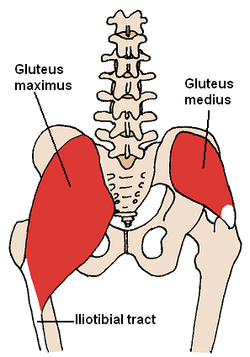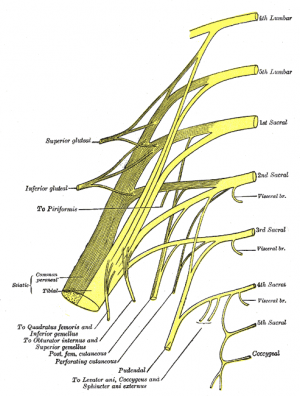Gluteus Medius: Difference between revisions
Alex Palmer (talk | contribs) No edit summary |
Alex Palmer (talk | contribs) No edit summary |
||
| Line 28: | Line 28: | ||
= Clinical Relevence = | = Clinical Relevence = | ||
= Evidence Based Research<br> = | = Evidence Based Research<br> = | ||
[[Donatelli.pdf]] | [[Image:Donatelli.pdf|left|Gluteus medius strengthening and the use of the Donatelli Drop Leg Test in the athlete.]] | ||
= References = | = References = | ||
<references /> | <references /> | ||
Revision as of 16:48, 26 June 2014
Original Editor - Alex Palmer,
Top Contributors - Alex Palmer, George Prudden, Kim Jackson, Ahmed Nasr, Joao Costa, Joanne Garvey, Candace Goh, Nupur Smit Shah, WikiSysop, Vidya Acharya, Pinar Kisacik, Rachael Lowe, Evan Thomas and Kai A. Sigel;
Anatomy[edit | edit source]
The gluteus medius is one of three gluteal muscles (minimus, medius and maximus). It is a superficial, fan shaped and broad muscle that lies in the posterolateral aspect of the pelvis, inferior to the iliac crest.[1] The gluteus medius has a broad origin on the external (gluteal) ilium and its tendon inserts into the lateral aspect of the greater trochanter.[2] The muscle is overlapped by the gluteus maximus and covered with a strong layer of fascia.[1]
Origin: External (gluteal) surface of ilium between anterior and posterior gluteal lines.[1] Reaches from iliac crest superiorly and as far as the sciatic notch inferiorly.[1] Superficial to gluteus maximus.[2]
Insertion: Lateral surface of greater trochanter.[2] A bursa seperates the tendon from the greater trochanter.[3]
Nerve: The Superior Gluteal Nerve (SGN) supplies the gluteus medius. The SGN originates at the sacral plexus at levels L4, L5 & S1.[4] The SGN divides into several branches, supplying both the gluteus medius and minimus as it passes horizontally between them both, prior to terminating at the tensor facsia latae.[4]
Blood Supply: Superior gluteal artery and superior gluteal vein.[2]
Palpation[edit | edit source]
Function[edit | edit source]
Clinical Relevence[edit | edit source]
Evidence Based Research
[edit | edit source]
References[edit | edit source]
- ↑ 1.0 1.1 1.2 1.3 Palastanga N, Field D, Soames R. Anatomy and Human Movement, Structure and Function. 4th ed. Edinburgh: Butterworth Heinemann; 2002.
- ↑ 2.0 2.1 2.2 2.3 Drake RL, Vogl AW, Mitchell, AWM. Gray's Anatomy for Students. 2nd ed. Philadelphia: Churchill Livingstone; 2010.
- ↑ Diop M, Parratte B, Tatu L, Vuillier F, Faure A, Monnier G. Anatomical bases of superior gluteal nerve entrapment syndrome in the piriformis foramen. Surg Radiol Anat 2002; 24: 155-9.
- ↑ 4.0 4.1 Kenny P, O’Brien CP, Synnott K, Walsh MG. Damage to the superior gluteal nerve after two different approaches to the hip. J Bone Joint Surg Br 1999; 81: 979-81.









